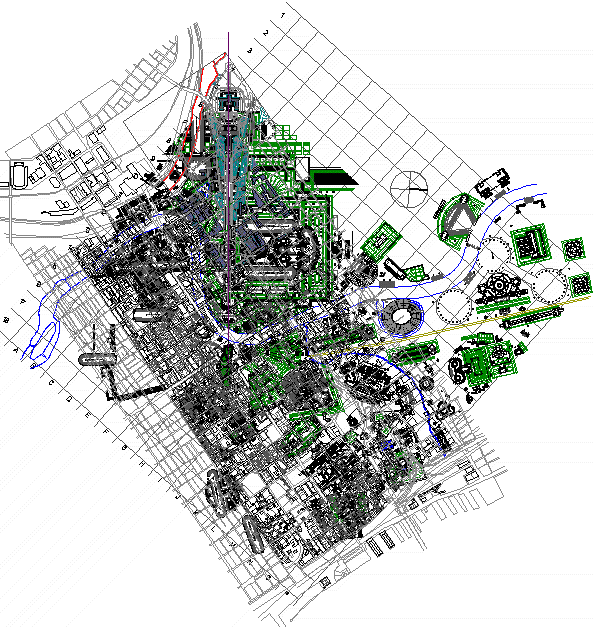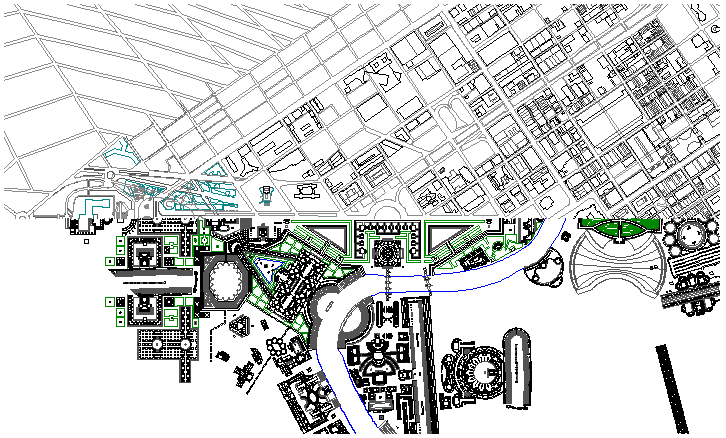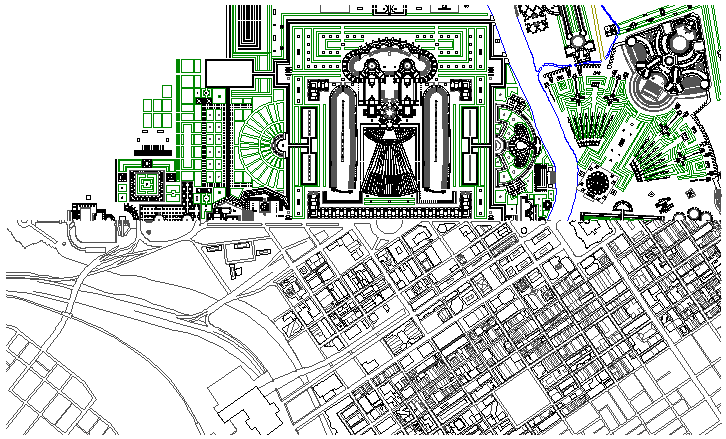1996.01.17
Piranesian gigantism
Piranesi's Campo Marzio is full of gigantic plans that are on a scale virtually unrealized in actual built architecture. In simple terms, this overuse of size can represent Piranesi's wish to express the grandness of ancient Rome. Beyond that, it is at this point difficult to make any other interpretation. The real issue seems to be that when so many gigantic plans are seen together, the sense of actual scale is lost. The large plans themselves quite naturally are in turn perceived as buildings that are only something like half their actual size. I think this normal misinterpretation of scale is part of the general enigma that the plan of the Campo Marzio conjures up. The plan seems to have multiple layers of unfathomability, and the ambiguity of scale is indeed one of these layers.
1fathom 1 a obs : a full stretch of the arms in a straight line; also : GRASP, REACH b : intellectual grasp, penetration or profundity : COMPREHENSION 2 a : a unit of length equal to 6 feet based on the distance between finger tips of a man's outstretched arms and used esp. for measuring the depth of water -- sometimes used in the singular when qualified by a number b archaic : any of several units of length varying around 5 and 51/2 feet
2fathom 1 archaic : to encircle (as for measuring) with outstretched arms 2 a : to measure by a sounding line b : to penetrate (as a mystery) and come to understand : comprehend where one had not understood previously : get to the bottom of ~ vi : to take soundings; also : PROBE, INVESTIGATE
fathomable 1 : that can be sounded 2 : capable of being comprehended
unfathomable a : INCOMPREHENSIBLE, INSCRUTABLE b : IMMEASURABLE, IMPENETRABLE
unfathomed 1 : not fathomed : UNSOUNDED 2 : UNDETERMINED, IMMENSE
The gigantism of Piranesi's Campo Marzio becomes perfectly evident when it is compared with other urban plans at the same scale. I have already done some comparative analysis between the Campo Marzio and parts of Center City Philadelphia, particularly the area around the Philadelphia Museum of Art because that building and the plan of the Benj. Franklin Parkway are themselves, in general, fine examples of an urban design gigantism practiced in America in the early twentieth century. I will have to do more drawings that show greater amounts of area, and I shall perhaps also compose some overlay drawings (meaning superimposed plans).
If anything, this exercise would be a lesson in scale and, in particular, gigantic scale. It could perhaps lead to a better understanding of Piranesi's intention and his ideas on urbanism, and it might also lead to a fine understanding of urban scale in general, where the Campo Marzio may actually shed some light on the urban situation of some actual cities, in this case, Philadelphia.
1996.04.23
gigantism of Piranesi's Campo Marzio
1997.05.28
projects
...retrieve the Campo Marzio/Parkway project comparisons (relating to the Parkway Interpolation project).
2002.02.06
ideas
4. ...the Parkway-Campo Marzio axis comparison.
2002.02.27
Match of the axis of life and the Benjamin Franklin Parkway

020227b.db
| |
2003.08.14 19:47
Campo Marzio and Philadelphia
Philadelphia's Benjamin Franklin Parkway matches exactly the long axis of Piranesi's Ichnographia Campus Martius, with the Philadelphia Museum of Art at one end matching the Nympheum Neronis, Logan Circle at the middle of the Parkway matches Hadrian's Tomb, and the tiny intercourse building at the other end matches the location of the Robert Indiana LOVE sculpture at the entrance to JFK Plaza.


Since it's inception in the early 1920s, the Benjamin Franklin Parkway was seriously considered a reenactment of the Champ Elysees from the Tuileries to the Arc de Triomphe. The Free Library and the Court House on Logan Circle even reenact the Palaces at the Place de la Concorde. I have never come across any reference comparing the Benjamin Franklin Parkway and Piranesi's Campo Marzio, but, who knows, maybe the Champs Elysees was somehow inspired by Piranesi's plan.
Ddot 2003.08.14 20:22
I think you're really grasping for connections to Piranesi. Why?
You can assign significance to almost anything, excluding Patrick Duffy's career, so why the attachment to Piranesi? Others attach significance to the Panopticon, or the Pantheon, or the Pyramids that occur in many places around the world..... I might ask the same question of them. It's not to say that the significance isn't warranted, but really, Stephen, you're like a conspiracy theorist : I can't ignore what you're saying, as much as I'd like to.
I have been on the Parkway a thousand times, and the thought had never crossed my mind to be so specific to link it to the Campo Marzio. There's so much activity at the edges that it seems a shame to be thinking of obscure texts that you should research and espouse.
Some things just work. Perhaps the Campo Marzio is one of those places that accommodate so many functions so well, that other cities couldn't help but try to copy it. But the success, whether visual, haptic, or otherwise, of these copy cat places have very little to do with the specifics of the Campo Marzio. Or does it? Maybe there aren't specifics to the Campo Marzio which are attributed to Piranesi? If there are, how have they evolved? I must admit, I couldn't pick out a plan of the Campo Marzio without a hint
Stephen Lauf 2003.08.14 20:37
I've been publishing data pertaining to Piranesi's Campo Marzio since 1996. This work is not a theory about some conspiracy, rather a disclosure of many things about Piranesi's Campo Marzio that have long gone undetected.
Much of Piranesi's Campo Marzio plan is of his own design, albeit based on a retelling of Rome's (architectural) history. The exacting relation in scale and pattern between the long axis of the Campo Marzio and Philadelphia's Benj. Franklin Parkway offers a real opportunity to step in Piranesi's otherwise virtual Roman world.
[There is an exact relationship between ignoring and ignorance as well.]
doctor 2003.08.14 21:24
stephen
dude, you are, not to mean any disrespect, too carried away by your own whim about the importance of piranesi's campo marzio....
most plans of typical block-modules american urban fabrics would match up with this, whcih does not mean that they referred piranesi when they were doing it..but just that they used a similar dimensional system, man
Stephen Lauf 2003.08.14 21:39
doctor,
The Benj. Franklin Parkway is indeed a reaction against the original grid of Philadelphia, and a true Beaux-Arts project/manifestation.
I am making a comparison rather than trying to say that Piranesi is somehow responsible for all this. If you knew the whole history of Philadelphia's layout and the design/execution of the Benj. Franklin Parkway, you would realize that the correspondence of the Campo Marzio long axis and the Parkway is more uncanny coincidence rather than something specifically designed or intended.
Again, the value (for me at least) is that the Benj. Franklin Parkway (now) offers a real manifestation of a Piranesi design that was otherwise only virtual.
Ddot 2003.08.14 21:41
but who's interested in these disclosures? How do they relate to our practice, our profession, or current architecture?
I'm trying here.
Ddot 2003.08.14 21:41
woops. just saw your last post.
I'm catching on, now.
It was around this time that the Blackout of 14 August 2003 occurred.
doctor 2003.08.15 02:34
looks like stephen's analyses etc. is not as inconsequential as i thought (and other people now think) - though a plan is not enough, if other information also exists, which corroborate to his hypotheses, then it actually does make sense
and everything in these forums here is not exactly valuable in 'creating' architecture..there are many posts that are just plain interesting, or force a line of thought
Stephen Lauf 2003.08.15 14:26
In further uncanny coincidental style, remember the Benjamin Franklin Parkway is named for the man who "discovered" that lightening and electricity are the same thing.
Franklin was quite a shocking guy.
Lao Tzu say, if the shoe fits, the foot is forgotten.
|


